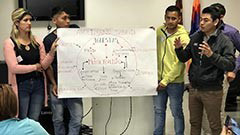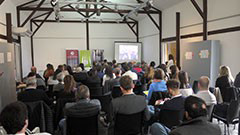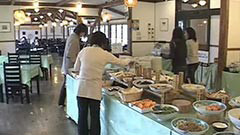- Home
- Our Work
- Types of Assistance
- Technical Cooperation
- Distance Technical Cooperation - JICA-Net
- JICA-Net multimedia-based learning materials Sample Activities
- Argentine Republic; To promote "One Village One Product" - Regional development by the initiative of local people -
Argentine Republic; To promote "One Village One Product" - Regional development by the initiative of local people -
Utilize Argentina "One Village One Product (OVOP)" project
 The workshop in Salta Province
The workshop in Salta Province
From July to October, 2019, we utilized JICA-Net multimedia-based learning materials, "Endogenous Regional Development through Community Initiatives" and "IRODORI Rural community empowerment through exploring local resources", when the workshop of "Project for Development of Inclusive Value Chains Oriented to the Market with OVOP Argentina Concept" conducted by JICA has been started.
This project, which has begun in north area of Argentina since June, 2019, was intended to build the inclusive and market-oriented value chain along "OVOP Argentina" concept, through strengthening of the ability of supporting the production group against the Ministry of Health and Social Development, and through developing, improving and promoting their local resources as agricultural processed products, artifacts or tourism service, etc. To drive the project forward, the materials were screened to promote an understanding of rural development by "OVOP".
What is the regional development by the initiative of local people?
In first chapter of "Endogenous Regional Development through Community Initiatives" (external link) introduces two kinds of approach in regional development, endogenous regional development (EnRD) and exogenous regional development (ExRD). EnRD means that regional development is promoted by the initiative of local people with utilizing of local resources, ExRD mainly means by industrializing with outside resources and capitals. In next each chapter, this material explains comprehensibly how regional development is leaded by EnRD through a few example in Japan; Oyama village in Oita Prefecture where OVOP movement originated, and so on.
 "Tsumamono" are used in Japanese traditional restaurants for decollate dishes
"Tsumamono" are used in Japanese traditional restaurants for decollate dishes
"IRODORI Rural community empowerment through exploring local resources" (external link) focuses on Kamikatsu village in Kochi Prefecture as a successful example of regional development. Kamikatsu village, which is a small village in mountains, has been losing their population before starting "IRODORI" project. In this project, they reached commercialization of garnishes as business, named "Tsumamono" which are used in Japanese traditional restaurants for decollate dishes. The material shows, "IRODORI" project has revitalized industry in village and empowered local people, and they became to have a strong sense of belonging, a sense of pride in their hometown.
Both of those materials are very helpful to explain that an importance of the regional development activities need to be deployed in steady and small scale, not as in large scale with using outside resources, and to show concrete successful examples against those who engage in "OVOP" activities such as administrators, enterprises, producers.
For correct understanding to purpose of the project.
 50 participants watched the materials at the workshop in Buenos Aires Province
50 participants watched the materials at the workshop in Buenos Aires Province
The workshop was held in 5 cities: Buenos Aires, Salta in Salta Province, Posadas in Misiones Province, San Fernando del Valle de Catamarca in Catamarca Province, Tornquist in Buenos Aires Province. A total of 300 participants watched the materials, including officials from the Ministry of Health and Social Development and related sector's officials from the central and target provinces who are the counterparts in this project, or producers, Co-op, NGO, university, etc.
"OVOP" project has a purpose to revitalize local region mainly with involving local people, not merely selling and producing a presentative product for each village. The materials were very useful for Argentina people who are not familiar with "OVOP" to understand this purpose. "Endogenous Regional Development through Community Initiatives" was easy to use for dividing the chapters, "IRODORI Rural community empowerment through exploring local resources" was easy to understand the way of success with mixing a fault example for participants, then especially get a good reaction from them.
Expectation to JICA-Net multimedia-based learning materials.
 A buffet-style restaurant serves food made from locally-grown ingredients. This scene got participants' interest
A buffet-style restaurant serves food made from locally-grown ingredients. This scene got participants' interest
I had a chance to watch one of JICA-Net multimedia-based learning materials when I joined Japan Overseas Cooperation Volunteers [JOVC] (3rd party, FY 2005), it was the first time that I knew JICA-Net Library.
We mainly conduct a workshop by using presentation software with picture and text and by working in each groups, however, I think it will attract participants' interest more if we use those video materials with visuals and sounds. Particularly, I felt a short-length movie was easy to use in seminar and workshop because participants were able to watch the movie with their concentrate. Regarding the contents, the scenes where introduced the concrete examples of things or activities are better to get participants' interest than where the interviewees were just speaking.
In the case of screening the material against participants who are not familiar with the theme, or who are going to learn new knowledge, it is important not to lose their interest. I think making materials are simpler and well-designed on presentation will be strong help for us in future.
Kotaro Mizoguchi
Acting Manager
Rural Development Division, Engineering & Consulting Department
NTC INTERNATIONAL Co., Ltd.
*The Material(s) mainly applied
Endogenous Regional Development through Community Initiatives
The process of regional development promoted by the initiative of local people using local resources, including natural, human, physical, and financial resources, and social capital, based on local culture, traditions, and skills is referred to as Endogenous Regional Development (EnRD), while the process of regional development promoted by governments utilizing outside resources with legal controls and technical innovation is called Exogenous Regional Development (ExRD). This material introduces the process of EnRD by presenting Japanese case examples, including that of former Oyama Town, Oita Prefecture; One Village One Product Movement (OVOP); former Yufuin Town, Oita Prefecture; former Meiho Village, Gifu Prefecture; Ikeda Town, Hokkaido Prefecture; and former Asuke Town, Aichi Prefecture.
IRODORI Rural community empowerment through exploring local resources
This material introduces "IRODORI" as an example of business model which was considered how to utilize the local resources from the viewpoint of outsider, then finally read as success with attachment and self-confidence approach toward local community in Kamikatsu village, Tokushima Prefecture. IRODORI is commercialize business of garnishes, named "Tsumamono" which are used in Japanese traditional restaurants for decollate dishes, gathering by local people in Kamikatsu village. This material includes introduction movie of the process of IRODORI and the participants, references as the training plan sheet for workshops, Q&A, the scenario with details.

- Thematic Issues
- Types of Assistance
- Partnerships with Other Development Partners
- Climate Change / Environmental and Social Considerations
- Evaluations
- Compliance and
Anti-corruption - Science and Technology
Cooperation on Global
Issues - Research
- JICA Development Studies
Program / JICA Chair - Support for the Acceptance of Foreign HRs / Multicultural and Inclusive Community
- About JICA
- News & Features
- Countries & Regions
- Our Work
- Thematic Issues
- Types of Assistance
- Partnerships with Other Development Partners
- Climate Change / Environmental and Social Considerations
- Evaluations
- Compliance and Anti-corruption
- Science and Technology Cooperation on Global Issues
- Research
- JICA Development Studies Program / JICA Chair
- Support for the Acceptance of Foreign HRs / Multicultural and Inclusive Community
- Publications
- Investor Relations
